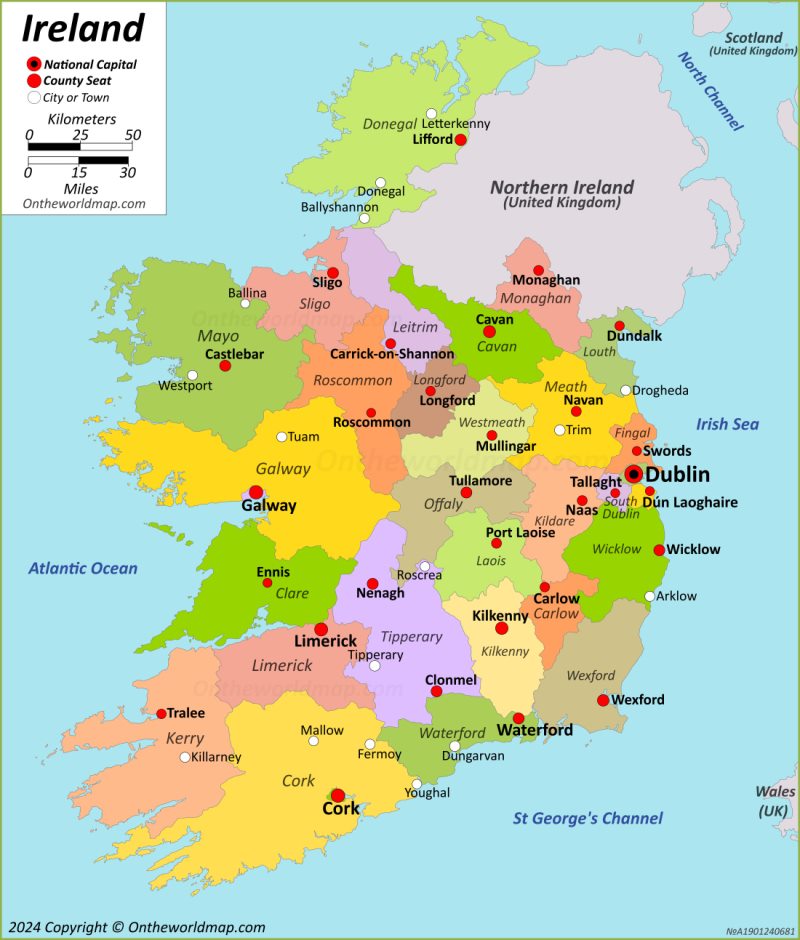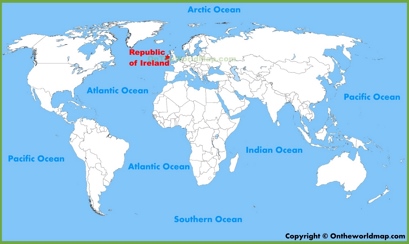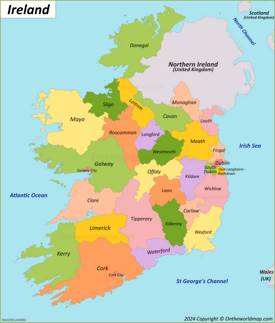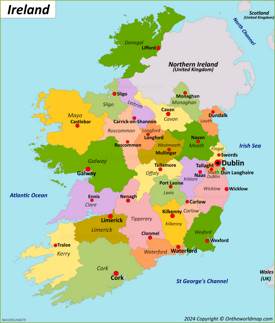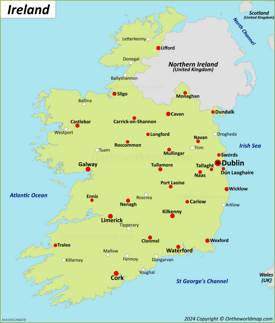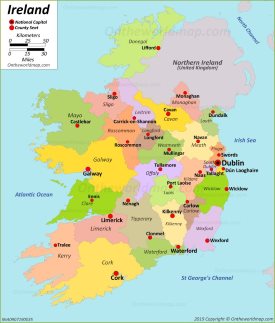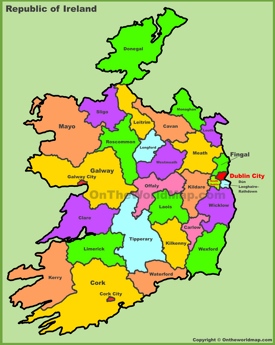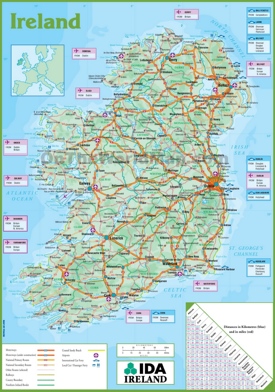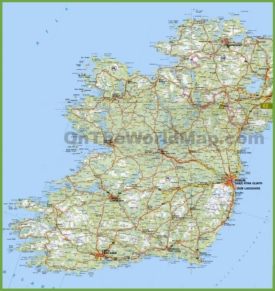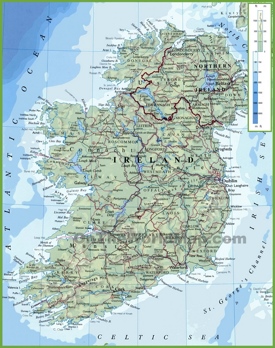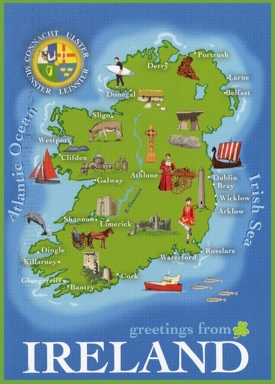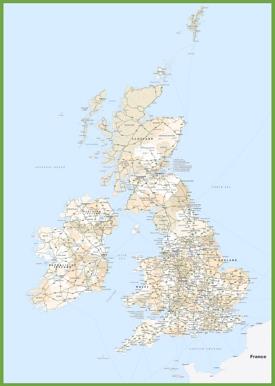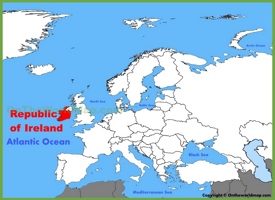Ireland Map
Description:
This map shows governmental boundaries of countries; islands, counties, county towns and major cities and towns in Ireland.
Size: 1100x1293px / 561 Kb
Author: Ontheworldmap.com
Previous version of the map
You may download, print or use the above map for educational, personal and non-commercial purposes. Attribution is required. For any website, blog, scientific research or e-book, you must place a hyperlink (to this page) with an attribution next to the image used.
Page Navigation
Ireland Location Map
Online Map of Ireland
Detailed Maps of Ireland
About Republic of Ireland
The Republic of Ireland, also known simply as Ireland, is a mesmerizing country boasting a rich history, stunning landscapes, and a vibrant culture. Situated in northwestern Europe, Ireland is the third-largest island in Europe, located to the west of Great Britain. It is separated from Great Britain by the Irish Sea and the North Channel. The country shares a land border with Northern Ireland, which is part of the United Kingdom. It is also surrounded by the Atlantic Ocean to the west, and the Celtic Sea to the south.
The Facts:| Flag: |
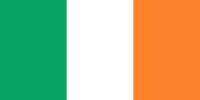
|
| Capital: | Dublin |
| Area: | 27,133 sq mi (70,273 sq km) |
| Population: | ~ 5,300,000 |
| Official language: | Irish, English |
| Religion: |
|
| Ethnic groups: |
|
| Currency: | Euro (€)(EUR) |
| Driving side: | left |
| Calling code: | +353 |
| Internet TLD: | .ie |
| Time zone: | UTC (GMT) Summer (DST) UTC+1 (IST) |
| Gross domestic product (PPP): |
|
| Gross domestic product (nominal): |
|
| Official government website: | www.gov.ie |
| Official presidential website: | president.ie |
Google Map of the Republic of Ireland
Cities in the Republic of Ireland
Dublin, the vibrant capital city, is located on the east coast of Ireland. It is renowned for its blend of old-world charm and modern sophistication. The city features an array of historical landmarks, including Dublin Castle, Saint Patrick's Cathedral, and Trinity College, home to the Book of Kells. Dublin's lively atmosphere is further enhanced by its bustling streets filled with traditional pubs, live music performances, and a thriving arts scene.
Apart from Dublin, Ireland boasts many other noteworthy cities. Cork, located in the southwest, is the second-largest city and is known for its diverse culinary offerings and vibrant arts community. Galway, situated on the west coast, is renowned for its bohemian atmosphere, medieval streets, and traditional Irish music sessions. Limerick and Waterford are also major urban centers that offer a mix of history, culture, and distinctive regional identities.
List of Largest Cities in the Republic of Ireland
- Swords (41,000)
- Navan (34,000)
- Bray (33,500)
- Ennis (28,000)
- Carlow (27,500)
- Kilkenny (27,000)
- Naas (26,000)
- Tralee (26,000)
- Newbridge (24,500)
- Balbriggan (24,400)
- Portlaoise (23,500)
- Athlone (23,000)
- Mullingar (22,700)
- Letterkenny (22,600)
Tourism in Ireland
Ireland's tourism industry thrives on its enchanting landscapes and hospitable people. The country's many attractions make it a sought-after destination for travelers worldwide. The Giant's Causeway, a UNESCO World Heritage Site located in Northern Ireland, is a geological wonder featuring unique hexagonal basalt columns. The breathtaking Killarney National Park in County Kerry, the tranquil beauty of the Aran Islands, and the picturesque town of Kilkenny with its ancient castle are just a few of the countless gems that await explorers.
Ireland's geographical location grants it diverse landscapes, including lush green hills, rugged mountains, dramatic coastlines, and picturesque lakes. The western and southwestern regions are particularly famous for their awe-inspiring cliffs, such as the Cliffs of Moher and the Ring of Kerry. The entire countryside is a paradise for outdoor enthusiasts, offering opportunities for hiking, cycling, fishing, and golfing.
Republic of Ireland is a captivating country that entices travelers with its awe-inspiring landscapes, rich history, and vibrant culture. From the bustling streets of Dublin to the serene beauty of its natural wonders, Ireland offers a truly unforgettable experience for all who visit.
Main sights in Ireland
- Rock of Cashel
- Cliffs of Moher
- Blarney Castle
- Ring of Kerry
- Killarney National Park
- Bunratty Castle
- National Gallery of Ireland
- Kilkenny Castle
- Wild Atlantic Way
- The Little Museum of Dublin
- St Patrick's Cathedral, Dublin
- National Museum of Ireland
Counties of the Republic of Ireland
| County | County town | Area | Population | Code | Region |
|---|---|---|---|---|---|
| Dublin City | Dublin | 46 sq mi (118 sq km) | 590,000 | D | Eastern and Midland |
| Dún Laoghaire–Rathdown | Dún Laoghaire | 49 sq mi (127 sq km) | 235,000 | D | Eastern and Midland |
| Fingal | Swords | 175 sq mi (453 sq km) | 330,000 | D | Eastern and Midland |
| Kildare | Naas | 654 sq mi (1,694 sq km) | 248,000 | KE | Eastern and Midland |
| Laois | Portlaoise | 664 sq mi (1,720 sq km) | 92,000 | LS | Eastern and Midland |
| Longford | Longford | 421 sq mi (1,091 sq km) | 47,000 | LD | Eastern and Midland |
| Louth | Dundalk | 321 sq mi (832 sq km) | 140,000 | LH | Eastern and Midland |
| Meath | Navan | 902 sq mi (2,335 sq km) | 221,000 | MH | Eastern and Midland |
| Offaly | Tullamore | 768 sq mi (1,990 sq km) | 83,000 | OY | Eastern and Midland |
| South Dublin | Tallaght | 86 sq mi (223 sq km) | 300,000 | D | Eastern and Midland |
| Westmeath | Mullingar | 705 sq mi (1,825 sq km) | 96,000 | WH | Eastern and Midland |
| Wicklow | Wicklow | 785 sq mi (2,033 sq km) | 156,000 | WW | Eastern and Midland |
| Cavan | Cavan | 746 sq mi (1,932 sq km) | 81,500 | CN | Northern and Western |
| Donegal | Lifford | 1,876 sq mi (4,860 sq km) | 167,000 | DL | Northern and Western |
| Galway City | Galway | 607 sq mi (1,572 sq km) | 84,000 | G | Northern and Western |
| Galway | Galway | 2,355 sq mi (6,100 sq km) | 195,000 | G | Northern and Western |
| Leitrim | Carrick-on-Shannon | 614 sq mi (1,589 sq km) | 35,500 | LM | Northern and Western |
| Mayo | Castlebar | 2,158 sq mi (5,588 sq km) | 138,000 | MO | Northern and Western |
| Monaghan | Monaghan | 500 sq mi (1,296 sq km) | 65,000 | MN | Northern and Western |
| Roscommon | Roscommon | 984 sq mi (2,548 sq km) | 70,500 | RN | Northern and Western |
| Sligo | Sligo | 710 sq mi (1,838 sq km) | 71,000 | SO | Northern and Western |
| Carlow | Carlow | 347 sq mi (898 sq km) | 62,000 | CW | Southern |
| Clare | Ennis | 1,329 sq mi (3,442 sq km) | 128,000 | CE | Southern |
| Cork City | Cork | 434 sq mi (1,123 sq km) | 224,000 | C | Southern |
| Cork | Cork | 2,811 sq mi (7,281 sq km) | 360,000 | C | Southern |
| Kerry | Tralee | 1,828 sq mi (4,735 sq km) | 156,000 | KY | Southern |
| Kilkenny | Kilkenny | 800 sq mi (2,072 sq km) | 104,000 | KK | Southern |
| Limerick | Limerick | 1,066 sq mi (2,760 sq km) | 206,000 | L | Southern |
| Tipperary | Clonmel & Nenagh | 1,662 sq mi (4,304 sq km) | 169,000 | T | Southern |
| Waterford | Waterford | 718 sq mi (1,859 sq km) | 127,500 | W | Southern |
| Wexford | Wexford | 913 sq mi (2,365 sq km) | 165,000 | WX | Southern |
Regions of Ireland: Northern and Western Region, Southern Region, Eastern and Midland Region.
Provinces of Ireland: Connacht, Leinster, Munster, Ulster.
Geography of Ireland
The Republic of Ireland is a country located in north-western Europe on the island of Ireland. It shares a border with Northern Ireland, which is part of the United Kingdom. The country is surrounded by the Atlantic Ocean, with the Celtic Sea to the south, the Irish Sea to the east, and the North Channel separating it from Scotland.
The landscape of Ireland is diverse and characterized by rolling hills, mountains, lakes, and rivers. The central lowlands are known as the Midlands and are predominantly flat with fertile agricultural land. The west is renowned for its rugged coastline, cliffs, and stunning peninsulas, such as the Dingle Peninsula and the Cliffs of Moher. The country's highest peak, Carrauntoohil at 1,038 meters, is found in the Macgillycuddy's Reeks mountain range. Additionally, Ireland features numerous lakes, including Lough Neagh, Lough Corrib, and Lough Mask, as well as famous rivers like the Shannon and the Liffey.
Largest Islands of Ireland by area
- Achill Island
- Inishmore
- Valentia Island
- Great Island
- Gorumna
- Bere Island
- Arranmore
- Inch Island
- Inishbofin
- Inishmaan
- Lettermore
- Inisheer
- Lettermullen
Major Rivers of Ireland
- Shannon
- Barrow
- Suir
- Munster Blackwater
- Bann
- Nore
- Suck
- Liffey
- Erne
- Foyle
- Slaney
- Boyne
- Moy
- Clare
- Inny
Largest Irish lakes
- Lough Neagh
- Lough Corrib
- Lough Derg
- Lower Lough Erne
- Lough Ree
- Lough Mask
- Lough Conn
- Lough Allen
- Upper Lough Erne
- Lough Melvin
- Lough Leane
- Poulaphouca Reservoir
- Lough Sheelin
- Lough Carra
Mountains of Ireland
- Carrauntoohil 3,407 ft (1,039m)
- Knocknapeasta 3,241 ft (988m)
- Brandon 3,123 ft (952m)
- Lugnaquilla 3,035 ft (925m)
- Galtymore 3,012 ft (918m)
- Baurtregaum 2,792 ft (851m)
- Slieve Donard 2,790 ft (850m)
- Mullaghcleevaun 2,785 ft (849m)
- Brandon Peak 2,760 ft (840m)
- Mangerton 2,749 ft (838m)
- Caherconree 2,740 ft (835m)
- Purple Mountain 2,730 ft (832m)
- Beenoskee 2,710 ft (826m)
- Lyracappul 2,707 ft (825m)
- Tonelagee 2,680 ft (817m)
History of the Republic of Ireland
The history of the Republic of Ireland is a complex and intricate tale that spans centuries. The earliest recorded inhabitants of the island were Celtic tribes, with Christianity introduced by Saint Patrick in the 5th century. The island remained fragmented politically until the 9th century, when the Viking raids began. These raids eventually led to the Anglo-Norman invasion of Ireland in the 12th century, bringing England's influence to the island.
This led to centuries of English colonization and conflict, including the devastating Great Famine in the mid-19th century, which saw mass starvation and emigration.
In the early 20th century, Ireland experienced a surge of nationalism, leading to the Easter Rising of 1916, a failed uprising against British control. However, this event paved the way for the War of Independence, which resulted in the creation of the Irish Free State in 1922. Six counties in the north-east of the island chose to remain part of the United Kingdom, forming Northern Ireland.
In 1949, the Irish Free State proclaimed itself a republic, severing its remaining ties to the British monarchy, and it was then renamed as the Republic of Ireland. Since gaining independence, Ireland has faced various social, political, and economic challenges, but it has also experienced significant progress, becoming an influential member of the European Union and achieving widespread prosperity. Today, Ireland is known for its vibrant culture, warm hospitality, and rich literary and musical traditions.
Page Navigation

